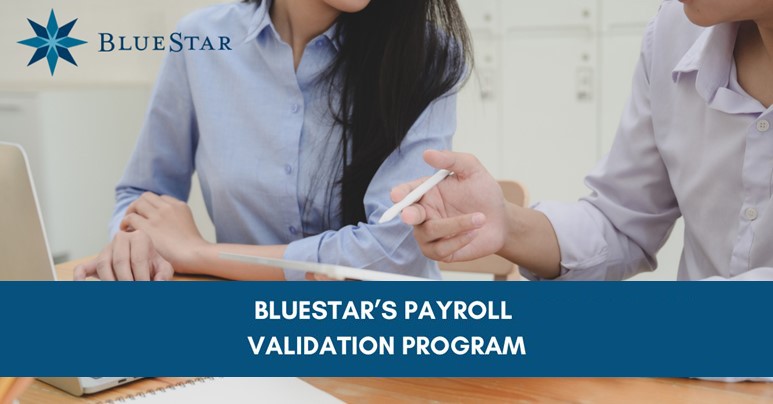
We know that you don’t like surprises – neither do we! We have devised our payroll validation program to ensure there are no nasty surprises at the end of the year. Unlike most recordkeepers and TPAs that focus on a year-end process, BlueStar does a deep dive into your payroll file EACH TIME YOU SEND IT to make sure that all of the I’s are dotted and T’s crossed. This article will review our Payroll Validation Program (PVP) to explain how it works and how it helps ensure your plan stays compliant. Our PVP has 3 components – a deferral verification, a contribution or employer contribution verification, and a loan verification.
Deferral Verification (DV):
Our DV process’s primary point is to validate that the employee’s payroll deductions align with their contribution elections. We use the compensation and deferrals you report in your payroll file to calculate a deduction rate. We then compare that deduction rate to the employee’s actual contribution election. If there is a discrepancy, we’ll review it and then alert you if we conclude that action is necessary. What sorts of issues does this process identify and resolve? Lots! Here are common issues we see:
- A new contribution election was not entered into the payroll system in a timely fashion; or
- A Roth election was entered into the payroll system as pre-tax or vice versa; or
- A dollar contribution election was entered as a percentage or vice versa; or
- New automatic enrollments or automatic increases were missed and need to be set up.
Contribution Verification (CV):
The primary point of our CV process is to validate that for plans that fund their matching or profit-sharing contributions each payroll that the employee is receiving the employer contribution that they should based on their eligibility status and your plan’s rules. We use the compensation and deferrals you report in your payroll file combined with our knowledge of your plan’s matching or profit-sharing rules and your employee’s eligibility status to calculate an expected employer contribution. We then compare that expected employer contribution amount with the actual employer contribution amount we see in your payroll file. If there is a discrepancy, we’ll review it and then alert you if we conclude that action is necessary. Here are common issues we are able to resolve with this process:
- Matching rates were not set up for an employee in payroll, particularly, when the eligibility for match and deferrals are not the same; or
- The employer contribution was not computed on all eligible compensation; or
- The matching cap was not applied so the employee is receiving too much match; or
- A tiered formula was not set up properly; or
- A safe harbor non-elective contribution was not given if the employee was eligible but did not enroll in the plan; or
- An employee received a contribution even though they are excluded from specific contribution types.
Loan Verification:
The primary point of our loan review process is to validate that your employees’ plan loans are on track to ensure that what’s happening in payroll matches the loan’s amortization schedule. Through our review process, we are able to immediately identify new loans that did not start on time, existing loans that have gotten behind schedule, and old loans that weren’t ended properly. Catching and helping you fix these issues helps to keep your plan compliant but also helps avoid adverse tax consequences or balloon payments for your employees.
Why we do what we do:
These payroll snafus are no big deal when they are caught immediately. You make a couple of updates and we are good to go for next time. But if no one is validating per payroll, then these issues can persist and sometimes are only caught months or even years later. When this happens, the employer can owe lost earnings and penalties, may need to enter a correction program with the IRS, and may need to adjust W2s or other tax documents. Catching these quickly is a HUGE benefit!
In addition to these payroll issues, our PVP process often also uncovers hidden compensation reporting issues. Proper compensation reporting is essential to your plan running smoothly. Compensation is at the center of every compliance test that is run and is front and center in every DOL or IRS audit. But it is all too common for there to be a disconnect between what your plan document defines as eligible compensation and what is happening in payroll. Our PVP reports help to uncover these issues. We often see a participant with a contribution election of 5% but the calculated deduction rate computed from the reported compensation and deferrals on the payroll file is something like 4.94% or 5.07%. Since it is very unlikely that a payroll specialist input a 5% election as 4.94% or 5.07%, the likely problem is that the compensation in the file either under- or over-reports the eligible compensation. When we see issues like that in our PVP, our compliance experts zero in and work with you and your payroll company to make sure we are receiving the right compensation so that your plan stays squeaky clean!
Our PVP process is just one reason that you can be confident that any surprises with BlueStar are good ones!

